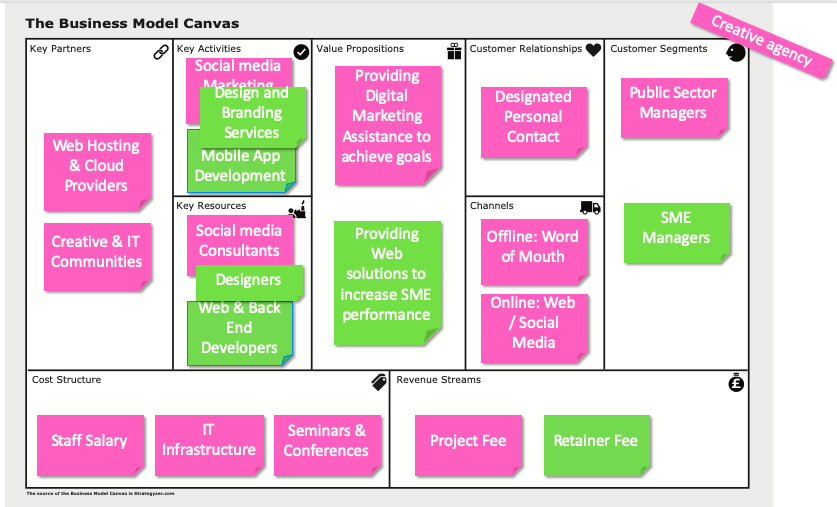“The Business Model Canvas identifies the assumptions you make about the way your business works – testing those assumptions is crucial.”
Steve Hobbs, Asking Better Questions
Blah, Blah, Blah…what?
Okay, so let’s start with a simple question - why would you want to use the Business Model Canvas?
It’s really rewarding to meet people who are passionate about business and their reasons behind starting a venture – it’s great, and, of course, it’s genuinely exciting. Sometimes, though, it can also sound a lot like ‘blah, blah, blah’ and that’s not good when you’re trying to engage with someone who might have something important to contribute to your business.
“Every business should be forced to go through the Business Model Canvas as it makes things simpler.”
Entrepreneur, Nottingham Trent University Business School
So, when you’ve got to present your ideas to people who matter, a clear and precise description will be better and more actionable by them. The benefit of the Business Model Canvas is it captures in a structured way the elements that combine to make your business work. Someone who is interested in what you’re saying can quickly focus on what’s important to them… and ask questions to find out more.
What is a business model?
The dictionary definition of a business model is:
“A plan for the successful operation of a business, identifying sources of revenue, the intended customer base, products and details of financing.”
If that seems a little lack-lustre then we think that Joan Magretta writing in the Harvard Business Review about ‘Why Business Models Matter’ summarises it quite nicely here:
“Business models…“are, at the heart, stories – stories that explain how enterprises work…also answers the fundamental question…how do we make money in business?”
What aren’t Business Models?
Sometimes, it’s just as easy to define what they aren’t. Business models aren’t plans - they don’t talk strategy or forecast finances.
The two are linked but a business model helps you to move quickly, to test your thinking and incorporate feedback, it’s a way of capturing thought and acting on it. Business plans are for the future while models are about the here and now.
BUT, don’t forget, even if you have a business plan in place, a business model can be created retrospectively and it can give you the edge when it comes to managing growth or change - say, introducing new markets, products or a refocus of business operations.
Also, modelling is just as effective for social enterprises as profit-generating businesses, in fact, it’s a useful tool regardless of what your business does. Change the terminology if it helps… clients, users or beneficiaries are all fine if you don’t have ‘customers’.
Ready to chat?
We’ve already heard that when it comes to conversation, models can help you to avoid that ‘Blah’, meaning that you can better articulate your business models to four key audiences focus you’ll have conversations with and questions for:
Customers
Advisors
Stakeholders
Investors
It’s a structured way of thinking about what you do; which business doesn’t need that?
Let’s get resourceful
It’s a good idea to use the tools that are available to you, freely and online.
Strategyzer has lots of useful resources and gives you access to the Business Model Canvas for your personal use – check out its YouTube channel too.
Why is it worth looking at Business Model Canvas?
Strategyzer has many testimonials that promote the benefits of the Business Model Canvas as a language for strategy and innovation.
The following key benefits are highlighted in particular:
Better conversations on strategy;
Creating a shared language;
Better ideas put on the table and better brainstorming;
Better teamwork;
Structured, practical outcomes to implement;
Better collaboration across disciplines;
Better collaboration across geographical boundaries.
Users also summarised the following reasons for using the Business Model Canvas:
New product/service development (21%)
Development of an entirely new business (36%)
Strategic reorientation (19%)
Renovate old business model (15%)
Tools to support the Business Model Canvas
Of course, there are other tools of strategy and innovation that can be used alongside the Business Model Canvas, so it doesn’t need to be used in isolation.
A few worth considering include:
SWOT analysis (Strengths, weaknesses, opportunities, threats)
Okay, so how can you use this in your business and what might it provide for you?
A very important point is to keep it simple. If you can, do it with fellow owners, directors or trusted peers so you can bounce ideas off each other and check your understanding.
So, you’ve established a scalable business model. That’s great. Down the line, though you may decide (or be encouraged) to venture into growing your business. Perhaps by developing a new customer segment. That’s a change to the existing model, and will almost certainly have an impact both on the offer you’re making and the infrastructure that meets that new customers’ needs.
Here’s a great example of the Business Model Canvas in action from a start up Creative Agency
At all times, consider how components fit together and use evidence to understand your current business model – what will need to change as you diversify?
Want more details on how to implement the Business Model Canvas for your organisation? Drop us a line at steve@askingbetterquestions.co.uk.

